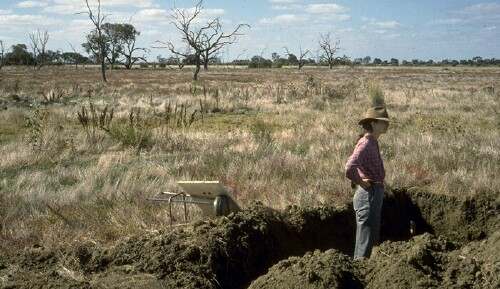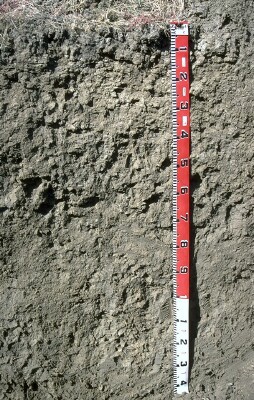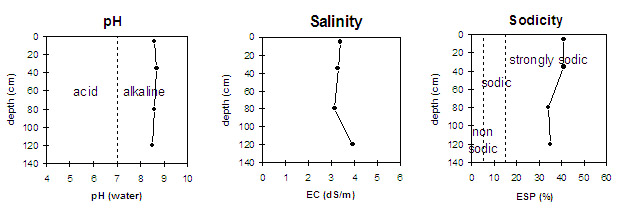LP1
| Location: Tragowel | Australian Soil Classification: |
| General Landscape Description: Closed depression of a swamp. Original vegetation includes Black Box and Red Gum as well as ‘Treeless Plain’ grassland. Also present are Barley Grass and Red Weed. | |
 LP01 Landscape |
Soil Profile Morphology
Surface Soil
| A1 | 0-10 cm | Greyish brown (2.5Y5/2); medium heavy clay; self mulching and cracking surface condition; strong coarse blocky, breaking down to strong fine blocky structure; very hard consistence dry; contains a few (2%) hard carbonate nodules and many (20-50%) coarse fragments; pH 8.6; sharp and smooth change to: |  LP01 Profle |
| Subsoil | |||
| B21 | 10-60 cm | Greyish brown (2.5Y5/2); heavy clay; strong coarse blocky, breaking down to strong fine blocky structure; friable consistence moist; contains very few (<2%) hard carbonate nodules; pH 8.7; gradual and smooth change to: | |
| B22 | 60-100 cm | Greyish brown (2.5Y5/2); medium heavy clay; strong coarse blocky, breaking down to strong fine blocky structure; weak consistence moist; contains very few (<2%) hard carbonate nodules (2-6 mm in size); pH 8.6; gradual and smooth change to: | |
| B23 | 100+ cm | Light brownish grey (2.5Y6/2); medium clay; weak consistence moist; contains very few (<2%) hard carbonate nodules (6 mm in size); pH 8.5. | |
Key Profile Features
- High clay content throughout the profile.
- Self-mulching and cracking surface condition.
- Accumulation of carbonates throughout the profile.
- Vertic properties (i.e. cracking surface condition).
Key Profile Characteristics
 |
Management Considerations:
Whole Profile
- The strongly alkaline profile suggests that some nutrients (e.g. iron, manganese, zinc, copper) may be poorly available to plants and that deficiencies are likely to occur. Deficiencies can be determined by plant tissue analysis.
- A very positive feature of this profile is that it has a very high inherent fertility throughout which is beneficial to plant growth.
- The profile is extremely saline throughout and is likely to restrict the growth of salt sensitive plant species (e.g. faba beans, linseed, chickpeas and lupins).
- The high level of exchangeable sodium and magnesium throughout may also result in nutrient imbalances and may even have a toxic effect on some plants.
Surface (A) Horizon
- The surface soil is self-mulching which provides a good seed bed that is friable and easily worked.
- When the soil is dry, heavy rains will move down soil cracks. This rapid recharge can be valuable for the survival of plants near wilting. When wet, the soil will swell and further infiltration will be relatively slow.
- Tillage of cracking clay soils should be avoided if the soil is wet (i.e. wetter than the plastic limit). At such a moisture condition, excessive tillage, trafficking or overstocking can result in structural degradation (e.g. compaction, smearing) occurring. Ideally, tillage should take place on clay soils such as these when the soil is drier than the plastic limit, down to at least the tillage depth.
- The densely and coarsely structured surface (A1) is strongly sodic and has a low exchangeable calcium to magnesium ratio (0.6) with slight dispersion. This indicates that tillage or over-stocking of the soil whilst in a moist to wet condition may result in structural degradation (e.g. surface sealing, increased cloddiness) occurring. Raindrop action on bare soil may have a similar effect, so it is important to maintain surface cover. Gypsum application may assist in improving surface soil structural conditions on such soils.
- The high wilting point value (23%) indicates that plants will be unable to utilise light rains when the soil is relatively dry.
- The levels of organic carbon measured at the pit site is low (this may or may not be representative of the whole paddock).
- The levels of total nitrogen measured at this pit site is moderate. However, this is best assessed by taking a bulked sample from across the paddock.
- The densely and coarsely structured upper subsoil (B21) is strongly sodic with a low exchangeable calcium to magnesium ratio (0.5). The extremely high salinity level has probably contributed to the decrease in dispersion to nil and is not likely to restrict water movement as significantly as would occur if the soil was not saline. Nevertheless, subsoil permeability will be low due to the low porosity of the clayey horizons.
- The subsoil displays vertic properties which indicates that significant shrinking and swelling occurs with wetting and drying cycles. This may disturb the roots of some plant species and has engineering implications (eg. disturbance to building foundations and fence lines).
- Within the region this soil is considered to be excellent. This is due to the soils self-mulching surface condition, excellent structure, good calcium levels, high clay and minimum sodicity levels.
- These soils flood annually and tend to become quickly saline after the soil is irrigated. Gilgai makes agriculture move difficult than other soils but it is still considered a better soil than Boort Clay and Macorna Clay.
- The soil requires four to five inches of rainfall for water holding capacity for lucerne and three and a half inches for pasture.


